Fact Sheet FS1290
Introduction and Identification
False-green kyllinga (Kyllinga gracillima) has become increasingly problematic in the Mid-Atlantic and Northeast regions over the past several years. Figure 1 shows a significant infestation in a New Jersey athletic field. It is a warm-season perennial weed that emerges in late spring/early summer when soil temperatures increase, and it grows rapidly throughout the summer months before going dormant after the first frost in the fall (Figures 2 and 3). False-green kyllinga is in the same plant family (sedges or Cyperaceae) as yellow nutsedge (Cyperus esculentus); both species have a triangular stem and three-ranked leaf arrangement (Figures 4 and 5). Yellow nutsedge is typically interspersed within the turfgrass canopy while false-green kyllinga tends to form a dense mat (Figure 6). This dense mat makes it appear similar to turfgrass in the summertime, but it usually has a lighter green color (Figure 7). When kyllinga is in bloom, look for a somewhat round, green seedhead above three leaves (Figure 8). The dense mat continues to expand as the underground stems (rhizomes) spread outwards ultimately displacing the desired turfgrass. Kyllinga infestations can also spread across larger distances by seed. False-green kyllinga tends to thrive at mowing heights common in turfgrass areas all the way from putting greens to lawns. Much like yellow nutsedge, it tends to thrive in wet areas. Although false-green kyllinga does not have tubers like yellow nutsedge, its rhizomes make it extremely difficult to control.
False-green kyllinga is also very similar to green kyllinga (Kyllinga brevifolia), but green kyllinga is typically found in the southern and western U.S. False-green kyllinga is the only species reported in northern regions of the U.S., which is probably due to greater cold tolerance than green kyllinga. Green and false-green kyllinga are very difficult to differentiate, but control and management of these two kyllinga species is thought to be similar.
Control
Kyllinga may be indicative of chronically excessive soil wetness, which should always be addressed as part of an overall treatment program. In general, false-green kyllinga is more difficult to control than yellow nutsedge. Due to the underground rhizomes and dense mat that forms, hand removal of kyllinga is difficult. However, physical removal using a sod cutter is an effective option. It is important to make sure that you cut deep enough to remove the rhizomes. False-green kyllinga rhizomes are typically closer to the soil surface than those of bermudagrass or other perennial warm-season grasses, so removal is more practical. The advantage of physical removal is that seeding or sodding can be completed immediately after removal with no herbicide residual concerns. However, this strategy is expensive and can result in the area being unavailable during the renovation.
Selective Herbicide Options
There are several herbicides that can provide effective kyllinga control when applied according to the label. Adequate weed control and safety (no injury) on the desirable turfgrass depends on the herbicide being applied to healthy, actively growing weeds and mature, actively-growing turfgrass at the rate indicated on the product label. Herbicide options listed below are safe for use on most cool-season turfgrass species including creeping bentgrass (Agrostis stolonifera).
Herbicide applications should be made shortly after kyllinga shoots have fully emerged in the spring. This timing is essential to reduce rhizome production and limit the total number of follow-up applications required for control. The first application is typically made in late May to mid-June. Make follow-up applications after re-growth is observed and sufficient shoot tissue is present for herbicide absorption. This is typically 4–6 weeks after the initial application.
Herbicides used for false-green kyllinga control/suppression will also provide yellow nutsedge control. However, many products registered for yellow nutsedge control will only suppress false-green kyllinga. Always consult the product label for information about the proper conditions for application.
Rotating herbicidal modes of action is important to prevent populations of herbicide-resistant nutsedge from developing. Relying on herbicides with the same mode of action for several consecutive years can accelerate the development of herbicide-resistant weeds. While herbicide resistance to kyllinga and sedge species is not thought to be widespread, there are reports of sedge species resistant to the class of herbicides known as ALS-inhibitors in turfgrass.
Imazosulfuron
Mode of Action: ALS inhibitor
Trade Name: Celero (8–14 oz./A)
This herbicide is relatively new to the turfgrass market. Although it is only labeled for control of annual kyllinga and nutsedge species, Rutgers research trials demonstrated excellent efficacy against false-green kyllinga at the low and high label rate. A single application of imazosulfuron at the low or high rate provided the same amount of control as two applications of halosulfuron-methyl at the high label rate. Results may not be evident for up to 3 weeks after application. Newly-seeded turfgrass should have received at least two mowings prior to application. Do not seed before 4 weeks after an application. Apply with a non-ionic surfactant at 0.25% v/v. Do not apply to golf course putting greens.
Halosulfuron-methyl
Mode of Action: ALS inhibitor
Trade Names: Sedgehammer (0.66–1.33 oz./A), Sedgehammer+, ProSedge 2, Manage (no longer sold), others
Halosulfuron-methyl can be safely applied to most cool- and warm-season turfgrass species. Results may not be evident for up to 3 weeks after application. While this herbicide has systemic properties, multiple applications will be required for long-term kyllinga control. Rutgers research trials have demonstrated that it provides good false-green kyllinga control after two applications spaced 4 weeks apart. This herbicide should be applied with a suitable surfactant as indicated by the label. Do not seed before 4 weeks after an application. Refer to the label for restrictions to newly-seeded areas. Do not apply to golf course putting greens. Include a non-ionic surfactant as directed by the label; Sedgehammer+ contains a non-ionic surfactant.
Sulfentrazone
Mode of Action: Protoporphyrinogen oxidase (PPO) inhibitor
Trade name: Dismiss (4–8 fl. oz./A); Echelon (8–24 fl. oz./A)
Note: Many products contain sulfentrazone in combination with other herbicides but often at rates too low for kyllinga or yellow nutsedge suppression.
Sulfentrazone can be applied to most cool-season turfgrasses and is a resistance management alternative to ALS-inhibiting herbicides. Sequential applications will provide some suppression; do not exceed 12 fl. oz./A of Dismiss per year. Sequential applications of halosulfuron-methyl or single applications of imazosulfuron have provided greater kyllinga control than sequential applications of sulfentrazone at 4 and 6 fl. oz. of Dismiss per acre in Rutgers research trials. When Dismiss was applied at 8 fl. oz./A, control was improved. Nutsedge or kyllingas treated with sulfentrazone will typically display injury symptoms within 48 hours after application. Good spray coverage is important for suppression with sulfentrazone. Seeding within 4 weeks of an application can inhibit establishment. Refer to the label for restrictions to newly-seeded areas. Dismiss can be applied at up to 4 fl. oz./A on creeping bentgrass; do not apply to putting greens or tees. Echelon is a combination of the pre-emergence herbicide prodiamine and sulfentrazone. Prodiamine does not provide pre-emergence kyllinga control, but will provide pre-emergence grass control. Kyllinga control provided by Dismiss NXT was similar to Dismiss in Rutgers research trials.
Combining Chemical and Cultural Practices
Long-term weed control is possible only if the underlying cause of the weed's competitive advantage is resolved. Much like nutsedge, kyllinga is often found in areas with excessive soil wetness, which likely increases its competitive advantage over desirable turfgrass. Especially in cases of severe infestation, modifications to the irrigation regimen and/or drainage should be considered in conjunction with herbicide programs. Seeding desirable turfgrass into infested areas should also be considered. Be sure to plan herbicide programs well in advance of seeding to make sure they will not reduce seedling establishment. Future research will evaluate herbicide programs in combination with seeding.
Mention or display of a trademark, proprietary product, or firm in text or figures does not constitute an endorsement by Rutgers Cooperative Extension and does not imply approval to the exclusion of other suitable products or firms.
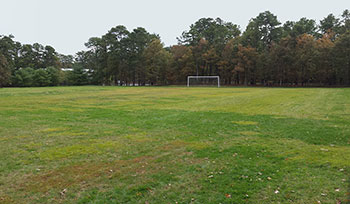
Figure 1: A severe false-green kyllinga infestation in an athletic field. The light green areas are kyllinga.
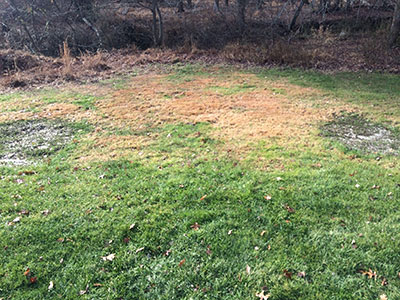
Figure 2: A patch of dormant false-green kyllinga surrounded by perennial ryegrass in a golf course rough.
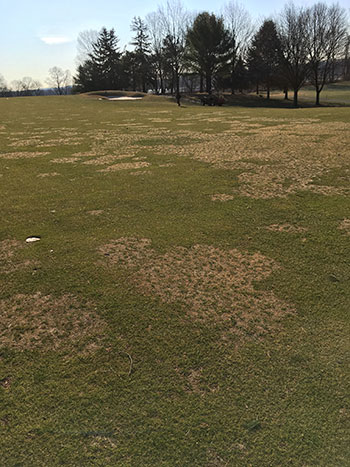
Figure 3: A patch of dormant false-green kyllinga surrounded by perennial ryegrass in a golf course fairway.
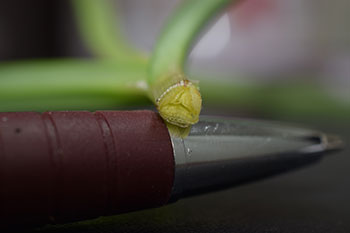
Figure 4. A triangular stem, characteristic of nutsedge and kyllinga species (resting on a pen for scale).
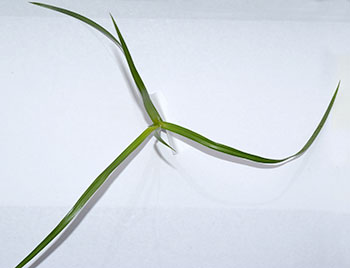
Figure 5. Three-ranked leaf arrangement characteristic of nutsedge and kyllinga species. When a single stem is viewed from the above these species have three leaves spaced at 120° angles. Most grass species have leaves on opposite sides of the stem at 180° angles.
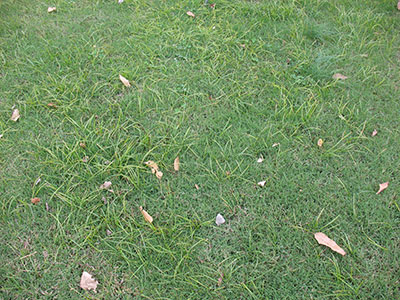
Figure 6. Yellow nutsedge interspersed within turfgrass.
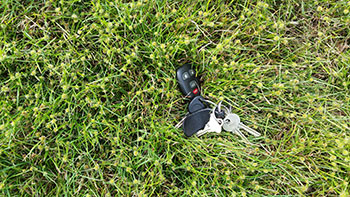
Figure 7. A dense mat of false-green kyllinga with seedheads.
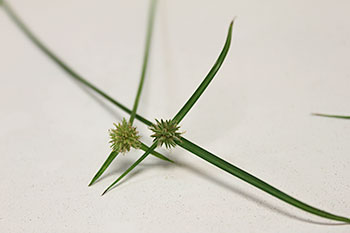
Figure 8. A close-up of false-green kyllinga seedheads.
June 2018
Copyright © 2024 Rutgers, The State University of New Jersey. All rights reserved.
For more information: njaes.rutgers.edu.
Cooperating Agencies: Rutgers, The State University of New Jersey, U.S. Department of Agriculture, and Boards of County Commissioners. Rutgers Cooperative Extension, a unit of the Rutgers New Jersey Agricultural Experiment Station, is an equal opportunity program provider and employer.

